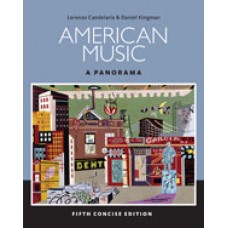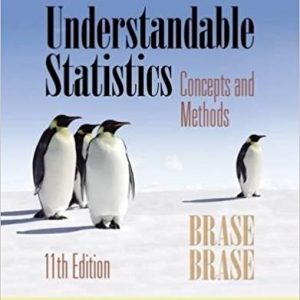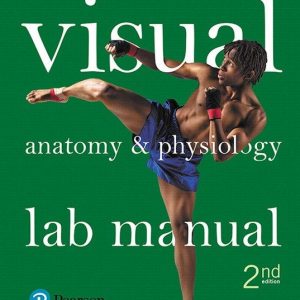Solution Manual for American Music A Panorama, Concise, 5th Edition

Product details:
- ISBN-10 : 1285446216
- ISBN-13 : 978-1285446219
- Author: Lorenzo Candelaria
This concise, accessible book describes American music as a panorama of distinct yet parallel streams–hip-hop and Latin; folk and country; gospel and classical; jazz, blues, and rock–that reflect the uniquely diverse character of the United States. Comparing and contrasting musical styles across regions and time, the author delivers a vision of American music both exuberant and inventive–a music that arises out of the history and musical traditions of the many immigrants to America’s shores.
Table contents:
- Part 1: Folk and Ethnic Musics
- Ch 1: The English-Celtic Tradition
- Imported Ballads
- Features Common to Most Ballads
- Naturalized Ballads
- Native Ballads
- Print and the Ballad
- Fiddle Tunes
- Print and the Fiddle Tune
- Play-Party Songs
- Key Terms
- Ch 2: The African American Tradition
- African Music and Its Relation to Black Music in America
- Religious Folk Music: The Spiritual
- Secular Folk Music
- Key Terms
- Ch 3: The American Indian Tradition
- Music in Indian Life
- Types of Songs According to Purpose
- Characteristics of Indian Music
- Indian Music and Acculturation
- Key Terms
- Ch 4: Latino Traditions
- The Legacy of the Spanish Conquest
- Sacred Music from Mexico
- Secular Music from Mexico
- The Caribbean and South America
- Key Terms
- Ch 5: Diverse Traditions: French, Scandinavian, Arab, and Asian
- The French Influence in Louisiana
- The Scandinavian Influence in the Upper Midwest
- Arab American Traditions
- The Asian Influence
- Key Terms
- Ch 6: Folk Music as an Instrument of Advocacy
- The Urban Folk Song Movement of the 1930s and 1940s
- Protest and Folk Song in the 1960s
- Freedom Songs and the Civil Rights Movement in the South
- Key Terms
- Part 2: Three Offspring of the Rural South
- Ch 7: Country Music
- Enduring Themes
- The “Country Sound”
- Commercial Beginnings: Early Recordings, Radio, and the First Stars
- Jimmie Rodgers: The Father of Country Music
- The West: Cowboys, Honky-Tonks, and Western Swing
- Postwar Dissemination and Full-Scale Commercialization
- The Persistence and Revival of Traditional Styles
- Key Terms
- Ch 8: The Blues
- Characteristics of the Blues
- Early Published Blues
- Classic Blues
- Blues and Jazz
- Boogie-Woogie
- Selling the Country Blues
- Urban Blues
- Blues at the Turn of the Century
- Key Terms
- Ch 9: Rock Music
- Rock’s Ties to Rhythm and Blues
- Reaching White Audiences
- The Influence of Country Music
- Trends from the 1960s to the Present
- Hip Hop
- Key Terms
- Part 3: Popular Sacred Music
- Ch 10: From Psalm Tune to Rural Revivalism
- Psalmody in America
- The Singing-School Movement
- The Frontier and Rural America in the Nineteenth Century
- Music among Smaller Independent American Sects
- Key Terms
- Ch 11: Urban Revivalism and Gospel Music
- Urban Revivalism after the Civil War: The Moody-Sankey Era of Gospel Hymns
- The Billy Sunday-Homer Rodeheaver Era: Further Popularization
- Gospel Music after the Advent of Radio and Recordings
- Key Terms
- Part 4: Popular Secular Music
- Ch 12: Secular Music in the Cities from Colonial Times to the Age of Andrew Jackson
- Concerts and Dances
- Musical Theater
- Popular Song
- Key Terms
- Ch 13: Popular Musical Theater and Opera from the Age of Andrew Jackson to the Present
- Minstrelsy and Musical Entertainment before the Civil War
- From the Civil War through the Turn of the Century
- The First Half of the Twentieth Century
- The Musical in Its Maturity: Show Boat to West Side Story
- The Musical since West Side Story
- Opera in America
- Key Terms
- Ch 14: Popular Music from the Jacksonian Era to the Advent of Rock
- Popular Song from the 1830s through the Civil War
- Bands and Band Music from the Civil War to John Philip Sousa
- Popular Song in the Gilded Age
- Tin Pan Alley: Popular Music Publishing Becomes an Industry
- Key Terms
- Part 5: Jazz and Its Forerunners
- Ch 15: Ragtime and Precursors of Jazz
- The Context of Ragtime from Its Origins to Its Zenith
- The Musical Characteristics of Ragtime
- The Decline and Dispersion of Ragtime
- Precursors of Jazz
- Key Terms
- Ch 16: Jazz
- The New Orleans Style: The Traditional Jazz of the Early Recordings
- The Swing Era and the Big Bands
- The Emergence of Modern Jazz: Bop as a Turning Point
- Jazz since the 1970s
- Key Terms
- Part 6: Classical Music
- Ch 17: The Search for an American Identity
- Music Education before the Civil War
- Music Education and Culture after the Mid-Nineteenth Century
- American Music and American Life
- America’s Virtuoso Cult
- Key Terms
- Ch 18: Twentieth-Century Innovation and the Contemporary World
- New York “Modernism”
- Midcentury Modernism
- The West Coast: Cowell and Partch
- New Technology and the New Music
- Minimalism
- Multimedia Art and Concept Music
- Classical Music and the Contemporary World
- Key Terms
- Ch 19: Film Music
- A Realistic Film of the American West
- Two Films about the Small Town and the Big City
- Three Career Film Composers
- The American Panorama on Film
- Key Terms
- References
- Glossary
- Index
People also search:
american music a panorama
american music project
pan american music initiative





